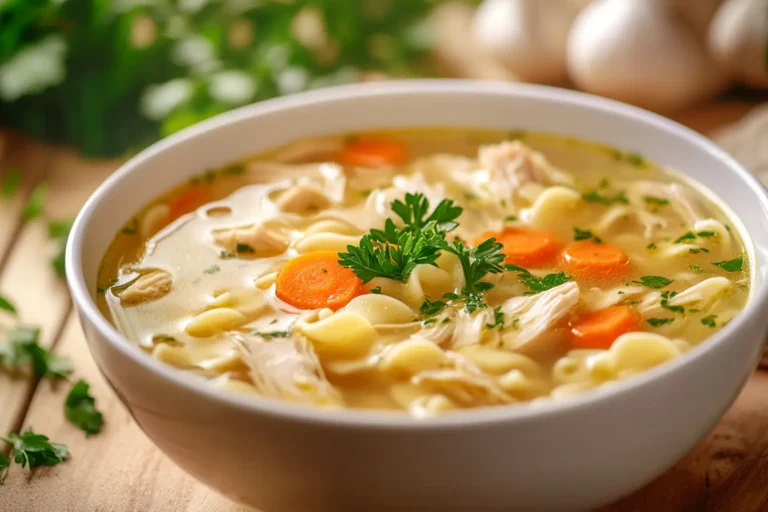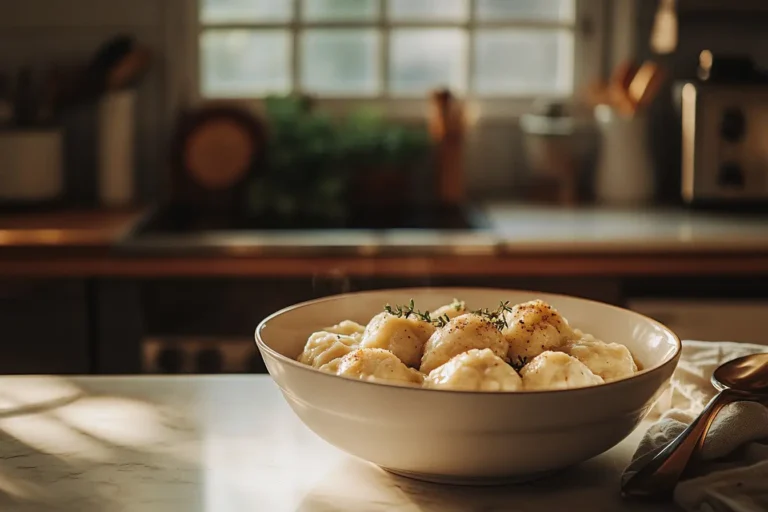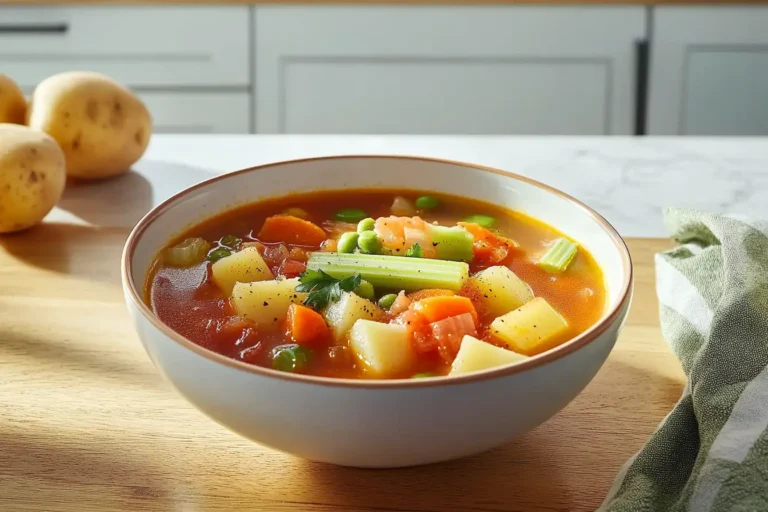The Best Fluffy Pancakes recipe you will fall in love with. Full of tips and tricks to help you make the best pancakes.

Table of Contents
Why Minestrone Soup is a Beloved Classic
Minestrone soup isn’t just a dish; it’s a warm hug in a bowl. Originating from Italy, this hearty soup is celebrated for its flexibility, allowing cooks to use whatever fresh vegetables they have on hand. It’s the perfect meal for any season, whether you’re cozying up in winter or enjoying a light, refreshing bowl in summer.
But what truly makes Minestrone soup special? Its rich blend of fresh, seasonal ingredients paired with comforting pasta or beans. From authentic Italian recipes like Cappelletti to classic pasta dishes, Minestrone showcases the best of Italian cuisine with its wholesome flavors and adaptability.
“A bowl of Minestrone isn’t just food—it’s a tradition passed down through generations.”
A Brief History of Minestrone Soup
Minestrone’s roots go back to ancient Rome, where meals were heavily influenced by agriculture. What started as a humble peasant dish made from leftover vegetables has now evolved into an iconic representation of Italian comfort food. Over time, it adopted more ingredients like beans, pasta, and olive oil, reflecting regional and cultural differences across Italy.
Looking for more Italian culinary inspiration? Explore dishes like authentic Cavatelli to pair with your Minestrone!
The Versatility of Minestrone Soup in Modern Cooking
One of the best things about Minestrone soup is its ability to adapt. Are you vegan or vegetarian? Skip the meat and load up on seasonal veggies and legumes. Need something quick? Toss everything into an Instant Pot or slow cooker for a hassle-free meal. Minestrone truly fits into any lifestyle or dietary preference.
Essential Ingredients for the Perfect Minestrone Soup

The magic of Minestrone soup lies in its ingredients. It’s like a symphony where each component plays its part perfectly. Let’s break down what you’ll need:
| Ingredient | Quantity |
|---|---|
| Olive Oil | 2 tbsp |
| Carrots | 2, diced |
| Celery | 2 stalks, chopped |
| Zucchini | 1 medium, diced |
| Canned Tomatoes | 1 can (14 oz) |
| Vegetable Broth | 4 cups |
| Pasta | 1 cup |
| Kidney Beans | 1 can (14 oz), drained and rinsed |
| Fresh Basil | To taste |
Seasonal Vegetables to Enhance Your Minestrone
The beauty of Minestrone is that you can add just about any vegetable you have on hand. Seasonal veggies like spinach, green beans, or even sunchokes can elevate the flavor. For tips on how to incorporate sunchokes, check out this guide to sunchokes.
Beans, Pasta, and Other Key Additions
Beans are a crucial ingredient, adding protein and a creamy texture. Kidney beans, cannellini beans, or chickpeas work wonderfully. Pasta, like ditalini or small shells, makes the soup more filling, creating a one-pot meal that’s perfect for any occasion.
Fresh Herbs and Flavor Boosters
What’s the secret to a flavorful Minestrone soup? Fresh herbs like basil, parsley, and oregano bring it to life. A drizzle of olive oil or a sprinkle of Parmesan cheese just before serving adds a touch of richness. For more soup ideas, check out Panera-inspired soups for additional inspiration!
How to Make Minestrone Soup: Step-by-Step Guide
Ready to bring this comforting dish to life? Let’s dive into the process of making Minestrone soup. It’s easier than you think, and with a little prep, you’ll have a steaming bowl of goodness in no time!
Prepping Your Ingredients: Tips for Success
Before you even turn on the stove, it’s all about preparation. Dice your carrots, celery, and zucchini into bite-sized pieces for even cooking. Drain and rinse your beans to remove excess sodium, and measure out your herbs and seasonings. Trust me, having everything ready will make cooking feel like a breeze.
“The key to a stress-free cooking experience? Mise en place – have all your ingredients prepped and ready to go!”
The Cooking Process: From Sautéing to Simmering
Let’s get cooking! Follow these steps:
- Heat olive oil in a large soup pot or Dutch oven over medium heat.
- Sauté the carrots, celery, and onion until softened, about 5 minutes.
- Add the zucchini, garlic, and herbs (basil, oregano, thyme), and cook for another 2-3 minutes.
- Stir in the canned tomatoes and their juices, breaking them up with a spoon.
- Pour in the vegetable broth and bring the mixture to a gentle boil.
- Add the beans and pasta, then reduce the heat to a simmer. Cook until the pasta is al dente, about 10 minutes.
- Season with salt and pepper to taste, and add more broth if you prefer a thinner soup.
If you’re using an Instant Pot, simply toss all the ingredients in, set it to pressure cook for 10 minutes, and let the magic happen. For slow cooker enthusiasts, cook everything on low for 6-8 hours or high for 3-4 hours. Either way, it’s foolproof!
Adjusting the Recipe for Different Preferences
The beauty of Minestrone soup lies in its flexibility. Want it vegan? Skip the Parmesan and use nutritional yeast for that cheesy flavor. Prefer a protein-packed version? Add cooked chicken or turkey sausage. The possibilities are endless, so don’t be afraid to get creative.
Quick and Easy Minestrone Soup Recipes
Sometimes, you just need a quick meal without compromising on flavor. These Minestrone variations are perfect for busy weeknights when you want something hearty and wholesome on the table in a flash.
30-Minute Minestrone Soup
This recipe is a lifesaver when time is tight. By using pre-chopped vegetables and canned beans, you can whip up a delicious bowl of Minestrone in just 30 minutes. Pro tip: Keep frozen veggies on hand for an even faster prep!
One-Pot Minestrone for Busy Weeknights
Hate doing dishes? This one-pot Minestrone is your new best friend. Everything cooks in a single pot, making cleanup a breeze. Pair it with some crusty bread, and you’ve got yourself a no-fuss dinner.
Instant Pot and Crock Pot Variations
If you love set-it-and-forget-it cooking, Minestrone soup is a match made in heaven for your Instant Pot or slow cooker. Simply add all the ingredients, set the timer, and let your kitchen appliances do the heavy lifting.
For more easy meal ideas, check out this list of quick and easy recipes. Perfect for when you’re short on time but still want to impress!
Healthy and Hearty: Nutritional Benefits of Minestrone Soup
Minestrone isn’t just comforting—it’s also incredibly good for you. Packed with vegetables, beans, and herbs, it’s a nutrient powerhouse that doesn’t skimp on flavor. Let’s take a closer look at why Minestrone soup deserves a spot in your meal rotation.
| Nutrient | Benefits |
|---|---|
| Fiber | Supports digestion and keeps you feeling full. |
| Vitamin A | Promotes healthy vision and immune function. |
| Vitamin C | Boosts immunity and skin health. |
| Protein | Helps build and repair tissues. |
| Antioxidants | Protects cells from damage and promotes overall wellness. |
Why Minestrone is a Low-Calorie Powerhouse
With its high vegetable content, Minestrone is naturally low in calories while still being filling. It’s a perfect choice for anyone looking to eat healthily without feeling deprived. Plus, it’s packed with water-rich ingredients, which help keep you hydrated.
Tips for Making a Vegan or Vegetarian Minestrone
Skip the meat and load up on legumes like lentils or chickpeas for a plant-based protein boost. Swap out chicken broth for vegetable stock, and use nutritional yeast instead of Parmesan for that cheesy kick. Not only is it delicious, but it’s also kind to the planet!
Common Problems When Making Minestrone Soup and How to Solve Them
Even with the simplest recipes, there’s always a chance for things to go a little off-track. Don’t worry, though—here are some common Minestrone soup mishaps and how to fix them like a pro!
Overcooked Vegetables: How to Avoid Mushy Texture
Ever ended up with veggies that feel more like mush than soup-worthy bites? It happens to the best of us. The trick is to add vegetables in stages based on their cooking time. Harder veggies like carrots and celery go in first, while softer ones like zucchini or spinach should be added toward the end.
“Pro tip: Keep a close eye on your pot during the simmering stage—it’s the difference between perfection and overcooking!”
Balancing Flavors: Avoiding Bland or Overly Salty Soup
No one likes a bland soup, but overly salty Minestrone isn’t great either. To strike the perfect balance:
- If it’s too bland: Add a splash of lemon juice, a sprinkle of Parmesan, or a touch more salt.
- If it’s too salty: Toss in a peeled potato to absorb some of the excess salt. Remove it before serving.
Fresh herbs, a drizzle of olive oil, or a dash of red pepper flakes can also elevate the flavor profile.
Storing and Reheating Minestrone Without Losing Quality
Got leftovers? Lucky you—Minestrone soup tastes even better the next day as the flavors meld together. Here’s how to store and reheat it properly:
- Store in an airtight container in the refrigerator for up to 4 days.
- For longer storage, freeze it without the pasta (it can turn mushy when thawed). Add fresh pasta when reheating.
- Reheat on the stovetop over medium heat, adding a splash of broth or water if it’s too thick.
Pro Tips for Perfecting Your Minestrone Soup

Want to take your Minestrone soup from good to great? Here are some expert tips to help you create a soup that’s as Instagram-worthy as it is delicious.
Choosing the Best Soup Pot or Dutch Oven
The right cookware can make all the difference. A heavy-bottomed soup pot or Dutch oven ensures even cooking and prevents sticking. Bonus: it’s perfect for those Instagram-worthy food shots!
The Secret Ingredient to Elevate Your Soup
What’s the secret to a standout Minestrone? It’s all about the finishing touches. A splash of balsamic vinegar or a swirl of pesto adds depth and complexity. Want a creamy touch? Stir in a dollop of ricotta cheese just before serving.
Garnishing Ideas for a Restaurant-Style Presentation
Presentation matters, even with soup! Here are a few ways to make your Minestrone look as good as it tastes:
- Top with fresh basil leaves or a sprig of thyme.
- Grate Parmesan cheese over the bowl for a cheesy finish.
- Serve with a side of toasted bread for dipping.
For more garnishing inspiration, check out this guide to creating restaurant-worthy finishing touches.
Traditional vs. Modern Minestrone: What’s the Difference?
Minestrone soup has evolved over centuries, and today, there’s no one-size-fits-all recipe. Let’s take a closer look at how traditional and modern versions differ.
Authentic Italian Minestrone Soup Recipe
Traditional Minestrone is all about simplicity. It uses seasonal vegetables, olive oil, and basic seasonings. There’s often no meat, and the focus is on letting the fresh ingredients shine. A good example is pairing it with homemade Italian bread, much like authentic Cappelletti recipes.
Modern Twists and Creative Variations
Modern Minestrone adapts to today’s tastes and convenience. It often features ingredients like quinoa, kale, or even a touch of cream for richness. Fancy experimenting? Add a spicy kick with chili flakes or a smoky flavor with roasted red peppers. Minestrone is a canvas—get creative and make it your own!
Serving and Pairing Ideas for Minestrone Soup

No bowl of Minestrone is complete without the right accompaniments. Here’s how to turn your soup into a full-on feast.
Perfect Bread and Side Dishes to Accompany Minestrone
There’s nothing like dipping warm bread into a hearty bowl of Minestrone. Opt for crusty Italian bread, garlic knots, or even homemade focaccia. Want something lighter? A fresh green salad with a zesty vinaigrette complements the rich flavors of the soup.
Wine Pairings for a Full Italian Experience
If you’re feeling fancy, pair your Minestrone with a glass of wine. A light Pinot Grigio or a medium-bodied Chianti works beautifully. Cheers to comfort food done right!
Frequently Asked Questions About Minestrone Soup
Let’s wrap things up by answering some of the most common questions about Minestrone soup.
What’s the Difference Between Pasta Fagioli and Minestrone Soup?
While both are Italian classics, Pasta Fagioli focuses on beans and pasta with a thicker consistency, whereas Minestrone includes a variety of vegetables and often has a brothier base.
What is the Thickening Agent for Minestrone?
Minestrone is typically thickened naturally by the starches released from the pasta and beans as they cook. You can also mash some of the beans for a creamier texture.
Is Olive Garden Minestrone Soup Good for You?
Yes! Olive Garden’s Minestrone is loaded with veggies, beans, and a light tomato-based broth, making it a healthy choice. Just watch the portion size if you’re keeping an eye on sodium or calories.
What is the Taste of Minestrone Soup?
Minestrone has a savory, slightly sweet flavor from the vegetables, balanced by the richness of the broth and herbs. It’s a comforting mix of hearty and fresh that warms the soul.
Bringing Comfort and Flavor to Your Table
And there you have it—Minestrone soup made easy, quick, and delicious! Whether you stick to tradition or put your own spin on it, this soup is a winner every time. So grab your soup pot, gather your ingredients, and get cooking. You’re just a few steps away from a bowl of pure comfort.
For more incredible recipes and cooking tips, check out Empirecipe’s recipe collection. Happy cooking!








